Teach close reading skills, slave narratives, and cosmic retribution with J.M.W. Turner’s The Slave Ship
J.M.W. Turner’s The Slave Ship is in the collection of the Museum of Fine Arts, Boston. See their website for more detailed information. Click on the painting for a high quality image.
On 6 September 1781, the Zong, a slave ship, left…the west coast of Africa, bound for Jamaica. The ship was cruelly overcrowded, carrying 442 Africans…The human cargo was manacled and packed so tightly, they had no room to move. But for the captain, Luke Collingwood, the more Africans he could squeeze in, the greater the margin of profit for both the ship’s owners and himself.
But by mid-November, the inexperienced Collingwood found himself in the mid-Atlantic, unable to navigate out of the calm winds of the Doldrums. The slaves, suffering from malnutrition, dysentery, scurvy and disease, began to die. By 28 November, 60 had died, along with seven crew members. Many more were falling sick. Collingwood began to panic—the delivery of dead slaves would earn the ship owners nothing. If, however, the Africans were somehow lost at sea, then the ship owners’ insurance would cover the loss at £30 per head.
So Collingwood…made an unimaginably cruel, but to his mind, logical decision. Rather than allow the sick slaves to die on board and be rendered worthless, he would throw them overboard—and hence claim the insurance. …Thus, on 29 November, 54 sick slaves, mainly women and children, were dragged from below deck, …and heaved from the ship into the ocean. The following day, more were murdered. In the end, Collingwood had thrown 133 slaves to their deaths. Many struggled and the crew had to tie iron balls to their ankles. Another ten slaves threw themselves overboard in what Collingwood described as an act of defiance.
—The Zong Massacre,which inspired J.M.W. Turner’s The Slave Ship, came to light when an insurance company, citing insurance fraud, refused to cover the losses of “cargo.” The resulting court cases (Gregson v. Gilbert) brought the depravity of the slave trade to the public consciousness and spurred on the abolition movement in Britain.
Look at The Slave Ship. Before reading the excerpt above, tell students the title of the piece and ask what is going on in this picture? Some early critics found this painting difficult to understand so students may as well. See how much they can decipher through a group discussion. Encourage students to identify the evidence that supports their reasoning. Students should likewise be encouraged to share wonderings and voice confusions. As the conversation slows, explain you are going to read an account of the Zong Massacre, the event that inspired the painting. After reading the excerpt ask how does this new insight change your understanding of the painting? What additional things do you see now?
Begin with art history
Joseph Mallord William Turner is commonly referred to as “the painter of light” and is recognized by many as the greatest British painter of the 19th century. As a child, Turner was a precocious artist selling pictures in the window of his father’s barber/wig shop at the age of 11. By the age of 13 he worked for several architects and studied under the topographical draftsman Thomas Malton. These architectural studies and exercises in perspective informed his work throughout his career. He entered the Royal Academy of Art in 1789 at the age of 14.
His architectural focus soon included nature’s majestic architecture. This ran counter to the art establishment that shunned landscape painting as a lowly art form akin to still-life painting. Rather, they held that the grand tradition of history painting was the noblest art form since it depicted the heights of human virtue. Turner contended that landscape painting could be equal in complexity and expressive potential to history painting and strove to depict the sublime and awesome power of nature. His initial idealized landscapes eventually became magnificent renderings of atmospherics and light. His storms contained moral outrage and his sunshine expressed a cosmic caress.
In The Slave Ship Turner depicts a typhoon powered by cosmic reckoning and divine retribution as it bears down on the slave ship Zong. The atrocities of the Zong massacre (described above) had galvanized the abolitionist movement in England and contributed to the abolition of slavery in Britain in 1833. Now Turner and other abolitionists wanted to use the strategic exhibition of The Slave Ship (1840) during an anti-slavery conference to reenergize the abolitionist movement and spread British anti-slavery efforts. In The Slave Ship Turner created a history painting that wedded the Romantic’s focus on the sublime with real world events and political motivations. While Turner continued to paint for another 11 years, many consider this his greatest painting.
Turner’s work is celebrated for taking Romanticism to new heights. It is also recognized for setting the stage for art movements to come. His focus on depicting light and dissolving forms into atmospheric colors links him to Monet and the Impressionists. The way he reveled in the physicality of his medium and his thick application of the paint with a pallet knife and his fingers to elicit an emotional response ties his work to modernist painting. During a Turner retrospective in 1966, Mark Rothko joked, ‘This guy Turner, he learnt a lot from me.”
Look like an art critic
This image of The Slave Ship from the Museum of Fine Arts, Boston offers more detail and background information.
Color
Point out and discuss: “The sun is God” were the final words Turner uttered from his deathbed and they express his increasing fixation on natural light in his paintings. The expressive potential of this light is manifested through Turner’s use of color. What do the colors in The Slave Ship remind you of and how does Turner’s use of color serve the artist’s intentions?
Turn, Talk, and Report Back (Possible answers: The bright reds, oranges, and yellows that shroud the slave ship create a sense of drama and fury. The ocean and atmosphere around the slave ship seems to erupt with violence and chaos. The yellow and white of the sun’s light swirls up like a flame that threatens to both illuminate the atrocity and purge the evil. The ship sails into the darkest parts of the painting. The dark purples and blues blend the sky and sea creating an overwhelming atmosphere of danger and foreboding. The complimentary colors, blues and oranges and purples and yellows intensify each other heightening the visual and emotional response. The top right corner and the bottom left corner are the lightest points of the composition and, in contrast, create a diagonal of saturated colors that connect the slave ship with the drowning slaves. The murky density of the ocean in the foreground full of partially identifiable sea creatures enhances the sense of anxiety and uncertainty. The immensity of the atmospheric coloring makes the small human elements seem even more frail. The colors and their strategic placement focus the violence of the storm on the slave ship as if it were some kind of cosmic reckoning.)
Line
Point out and discuss: As an element of art, line is the use of outlines, implied lines, and patterns of marks to create an identifiable path in an artwork. They are oftentimes used to lead the viewer’s eyes around the composition, organize significant elements, and communicate information. The use of diffused light in Turner’s landscapes oftentimes softened the landscape to abstraction and disintegrated form and line. What lines do you see in The Slave Ship and how does Turner’s use of line or the lack of line serve his intentions?
Turn, Talk, and Report Back (Possible answers: Most of the painting is a blur of colors so the few elements shown with distinct lines take on added significance. The ship’s masts are rendered with hard slashing diagonal lines, underscoring the ship’s instability and the fury of the storm. The ship’s lines become less distinct as they near the water as if the ocean was devouring the ship. The other distinct lines are the drowning slaves shown in the foreground. The most distinct is the shackled leg that points back across the composition to the ship. The distinct lines of the leg also attract the viewer’s attention to the chains and the open, despairing hands that rise up out of the water. Together, these elements point accusingly at the ship and visually anchor the fleeing ship to the drowning slaves. The blurred brush strokes and indistinct lines of the waves in the foreground depict the ocean as roiling with the energy of the storm and the feeding frenzy of the sea creatures devouring the slaves. The murkiness and lack of identifiable markers draw on the viewer’s imagination and make the unknown that much more unsettling. The lack of a distinct horizon line makes the ocean and the sky writhe together in an all-enveloping, violent, swirling motion. This turbulent vertical movement suggests a cosmic retribution is raining down on the frail ship and its loathsome crew.)
Title and Text
Point out and discuss: The Slave Ship was originally titled Slavers Throwing Overboard the Dead and Dying—Typhon Coming On. In addition, Turner exhibited the painting with an excerpt from his unfinished poem Fallacies of Hope (1812),
Aloft all hands, strike the top-masts and belay;
Yon angry setting sun and fierce-edged clouds
Declare the Typhon’s coming.
Before it sweeps your decks, throw overboard
The dead and dying – ne’er heed their chains
Hope, Hope, fallacious Hope!
Where is thy market now?
How does the original title and the poem impact your reading of The Slave Ship? How does Turner’s use of text support his visual efforts?
Turn, Talk, and Report Back (Possible answers: The longer title gives additional context for the scene. This title underscores that the dying slaves in the water had been thrown overboard by the departing ship and that the ship is being chased down by a typhoon. The structure of the longer title suggests a causal relationship between the actions of the slavers with the oncoming storm, further reinforcing the sense of cosmic retribution. The poem likewise adds context and helps the viewer recognize important details. The poem’s final two lines give added emphasis to the despair depicted in the painting. The final line highlights Turner’s abolitionist leanings and reminds the reader that this calculated depravity is driven by a sordid market for slaves.)
Think like an artist
Like Turner, other artists have used their art to call attention to the horrors of the Middle Passage and the cruelty of the slave trade.
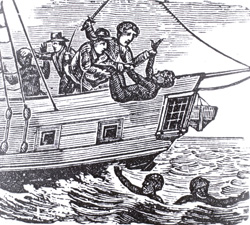
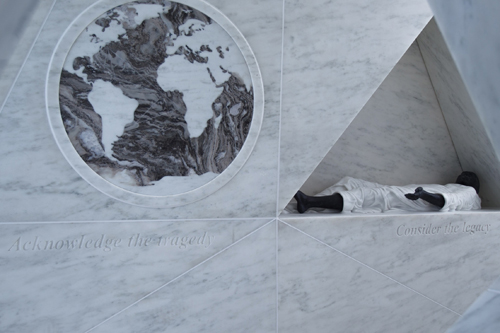
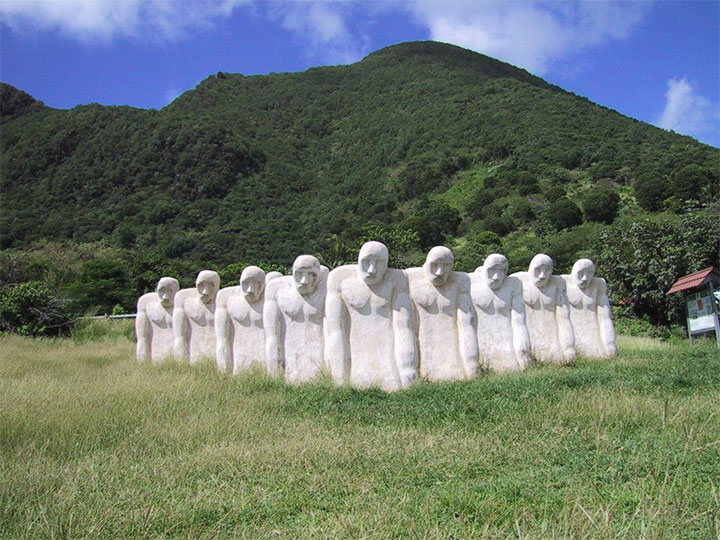
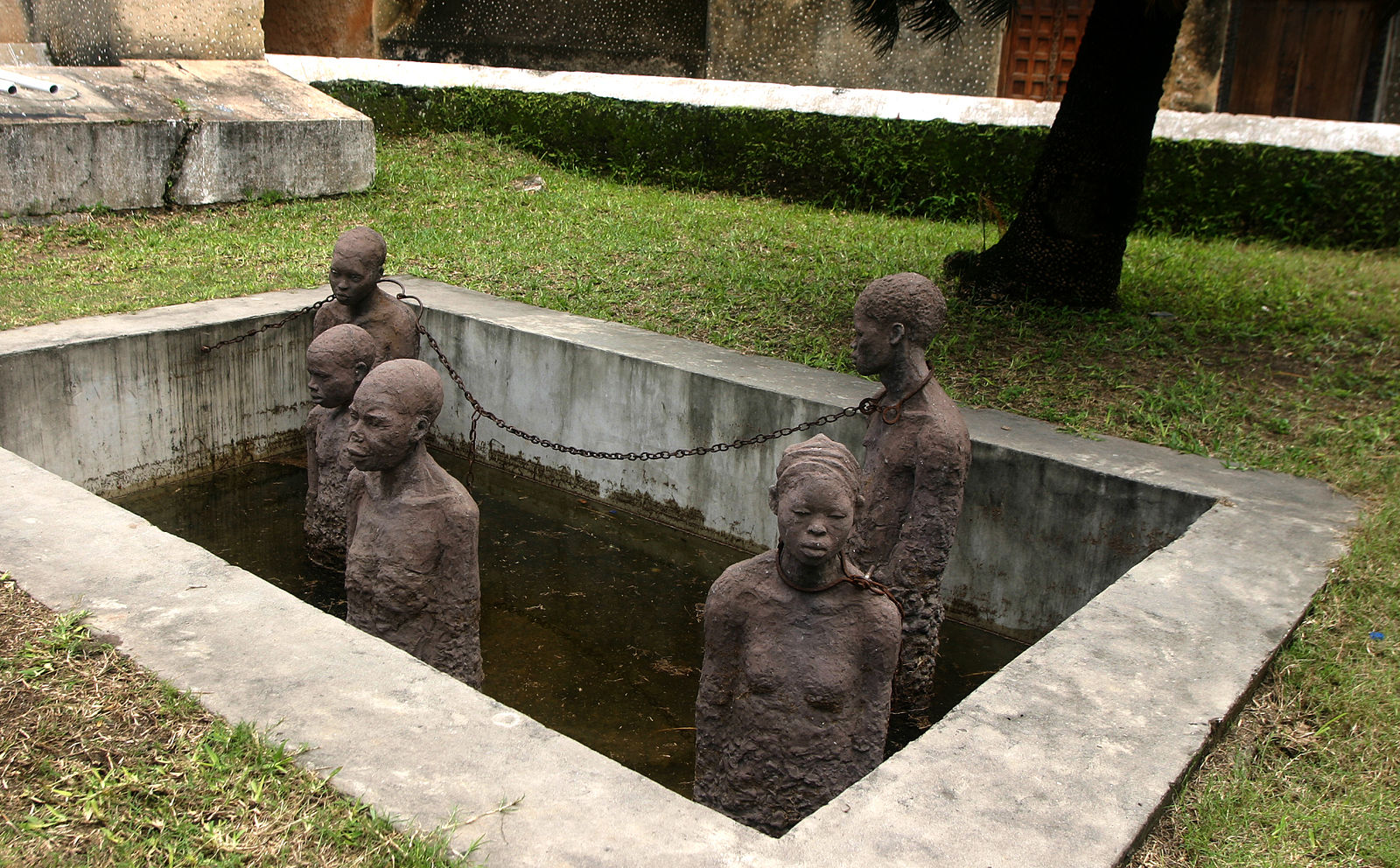
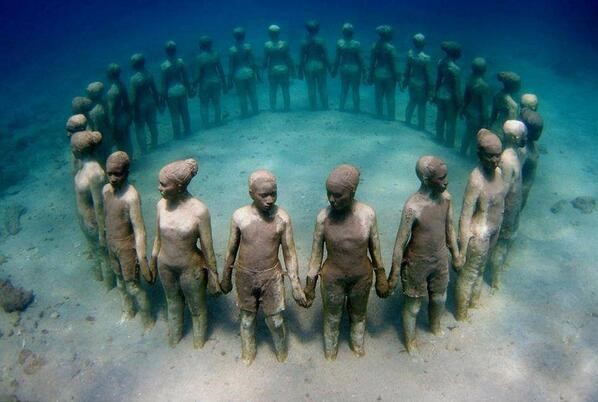
- This unattributed etching is frequently used to illustrate the Zong massacre
- The Ark of Return by architect Rodney Leon is a permanent memorial to honor the victims of slavery and the transatlantic slave trade at the United Nations.
- Memory Cap 110 and Fraternity by Laurent Valere commemorates the slaves who died when their captive ship ran aground on the rocks of Anse Caffard in southern Martinique.
- Memory for the Slaves by stone sculptor Clara Sörnäs recognizes the role Zanzibar played as a transit port for African slaves going to Mauretania and the Arabic countries.
- Viccisitudes by underwater installation artist Jason DeCaires Taylor has become a much-heralded memorial to drowned African slaves, even though the artist never intended it to be. This is a great case study for exploring artist intentions and audience interpretations.
- For additional memorials about slavery, serfdom, and emancipation visit this site.
Compare how this art evokes the atrocities of the Middle Passage with Turner’s The Slave Ship. Do they share any imagery? Do you think one of these pieces is more effective at raising public consciousness? What elements in the artwork make it especially effective for you? How would your comparison of these artworks inform a piece of art you might make to raise public awareness about a social injustice?
Life Lesson
Integrate reading, writing, and art making.The abolitionist Thomas Clarkson recognized that art and artifacts were able to influence public opinion more than mere words alone so he collected chests of African crafts and goods to accompany his anti-slavery lectures. Clarkson went on to write The History of Abolition of the African Slave-Trade. This book inspired Turner to paint The Slave Ship. As noted above, Turner likewise exhibited his painting with poetry. Reading, writing, and art making creatively and intellectually intertwine. Artists and life’s problem solvers use a healthy dose of all three to fully engage their minds.
Related videos
- Simon Schama’s J.M.W. Turner 4 of 4 (14:31) describes Turner’s final works, including The Slave Ship, and his influence. Preview this with your students in mind as the drowning of the slaves is quite graphic and disturbing. To create a context for part 4, you may want to view with the preceding Simon Schama’s J.M.W. Turner 3 of 4 (14:58).
- Turner, Slave Ship (Slavers Throwing Overboard the Dead and Dying, Typhoon Coming On), 1840 (4:01) analyzes key elements of the painting.
- The Great Artists—The English Masters—Turner (49:26) offers a comprehensive overview of Turner’s life and work.
Integrating into Your Curriculum
Artists oftentimes use common visual strategies or signposts to alert viewers to significant details in their art. Here are some ideas for using these visual signposts to unpack a work of art. Remember, the close reading skills in art appreciation are similar to the close reading practices taught in reading.
Art-based Inquiry Study: J.M.W. Turner’s The Slave Ship sets the stage for an art-based inquiry study that uses slave narratives and ekphrastic poetry to give voice to the Zong massacre and the horrors of the slave trade’s Middle Passage.
Literature Links: What piece of literature would you partner with The Slave Ship?
The Slave Ship could inform the study of slave narratives or abolitionist literature such as:
- Olaudah Equiano’s The Interesting Narrative of the Life of Olaudah Equiano, Written by Himself
- Harriet Ann Jacob’s Incidents in the Life of a Slave Girl
- Frederick Douglass’ Narrative of the Life of Frederick Douglass, an American Slave
- Harriet Beecher Stowe’s Uncle Tom’s Cabin
- This site is rich with excerpts from slaves narratives, including the Middle Passage
The Slave Ship could inform the study of Romantic poetry such as:
- William Wordworth’s Lines Composed a Few Miles above Tintern Abbey
- Samuel Taylor Coleridge’s The Rime of the Ancient Mariner
- Walt Whitman’s Song of Myself
Writing opportunity: Comparison essay. J.M.W. Turner and Pablo Picasso both used their characteristic visual vocabulary to respond to social injustices that plagued their world. Turner’s The Slave Ship highlighted the atrocities of the slave trade. Picasso’s Guernica highlighted the atrocities of modern warfare. Both artists depicted a specific event to highlight universal issues. Have students write a comparison essay that analyzes these two paintings.
How would you use this painting to elaborate on one of your units of study? Please share if you have other ideas on how to teach The Slave Ship by J.M.W. Turner as an English/language arts lesson plan.

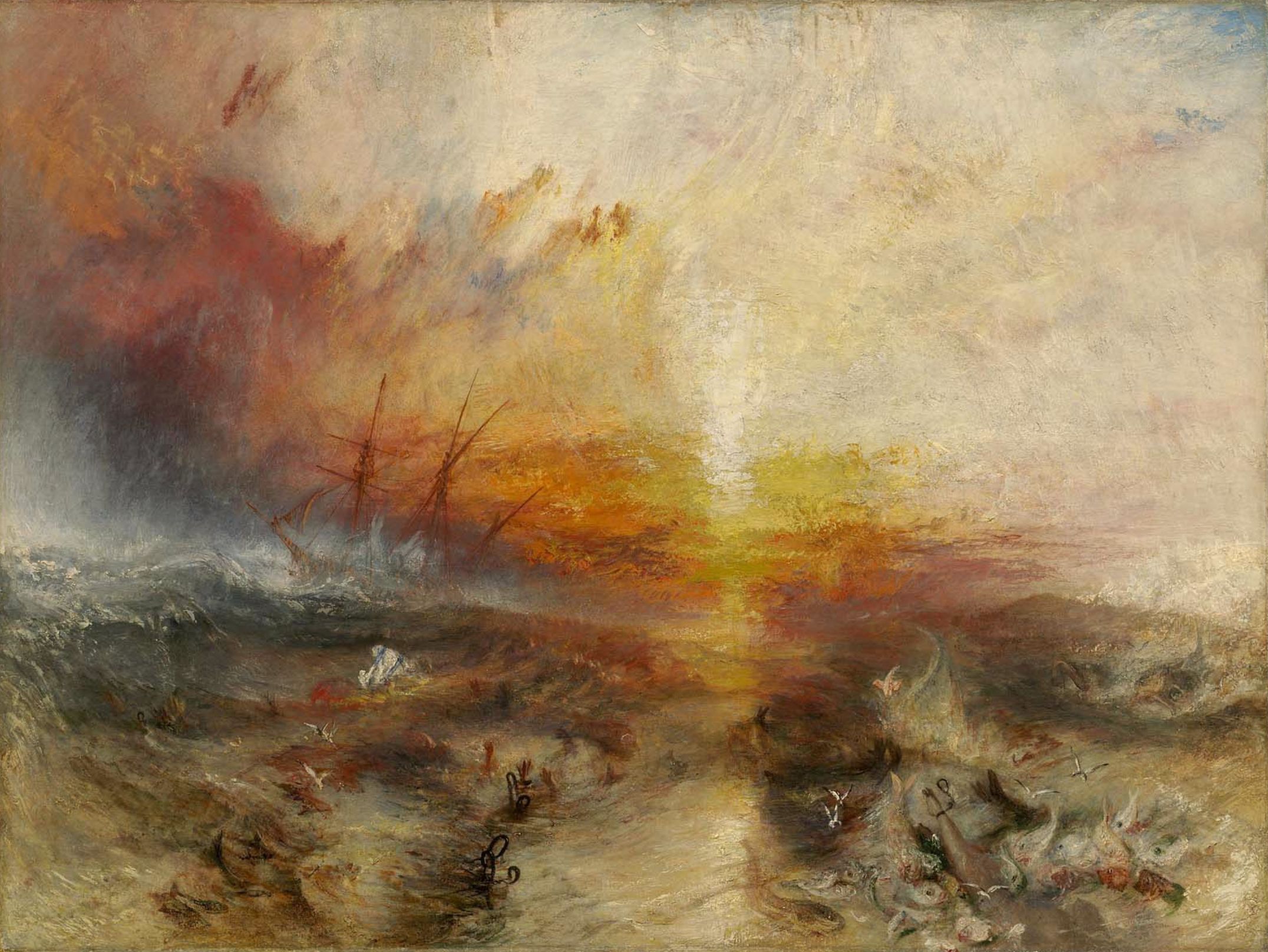
Comments are closed, but trackbacks and pingbacks are open.